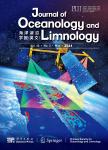A re-investigation of the bloom-forming unarmored dinoflagellate Karenia longicanalis(*** umbella)from Chinese coastal waters
A re-investigation of the bloom-forming unarmored dinoflagellate Karenia longicanalis(syn. Karenia umbella ) from Chinese coastal waters作者机构:Department of Science ResearchBeijing Museum of Natural History College of Life Science and TechnologyJinan University Key Laboratory of Eutrophication and Red Tide Prevention of Guangdong Higher Education InstitutesJinan University Marine Biological SectionDepartment of BiologyUniversity of Copenhagen School of Science & TechnologyOpen University of Hong Kong Key Laboratory of Sustainable Development of Marine FisheriesMinistry of AgricultureYellow Sea Fisheries Research InstituteChinese Academy of Fishery Sciences Wenzhou Marine Environmental Monitoring Center StationState Oceanic Administration
出 版 物:《Journal of Oceanology and Limnology》 (海洋湖沼学报(英文))
年 卷 期:2018年第36卷第6期
页 面:2202-2215页
核心收录:
学科分类:07[理学]
基 金:Supported by the Youth Backbone Training Plan of the Beijing Academy of Science and Technology(No.201602) the National Nature Science Foundation of China(No.41606175,41576162) the National Key R&D Program of China(No.2017YFC1404301) the Strategic Priority Research Program of the Chinese Academy of Sciences(No.XDA1102030401)
主 题:harmful algal blooms(HABs) phytoplankton morphology phylogeny large subunit(LSU)rRNA internal transcribed spacer(ITS)
摘 要:The dinoflagellate genus K arenia is known for recurrent harmful blooms worldwide. However, species diversity of the genus is generally overlooked owing to the difficulty of identifying small unarmored dinoflagellates. We have established four clonal cultures of K arenia longicanalis isolated from the type locality, Hong Kong harbor(strain HK01) and other three locations along the Chinese coasts(strains YB01, DT01, and NJ01). The morphology of the strain was studied by light and scanning electron microscopy(LM and SEM) and the pigment composition analyzed by high-performance liquid chromatography. We provide the first molecular data of K. longicanalis based on the large subunit(LSU) rRNA gene sequence and internal transcribed spacer(ITS). The four strains showed identical LSU rDNA sequences with a similarity of 99.4% to the holotype of K arenia umbella(strain KUTN05) from Australia. In the ITS phylogeny, the sequence of K. umbella branched between the Chinese strains of K. longicanalis. A careful comparison of the morphology of K. longicanalis and K. umbella reveals the similarity in the diagnostic characters. Diff erences may appear due to the sample treatment for SEM. We conclude that K. umbella is a junior synonym of K. longicanalis.



